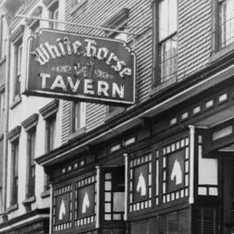White Horse Tavern
Highlights
Historic literary bar serving drinks & pub fare.






























Historic literary bar serving drinks & pub fare.
"This West Village landmark with its original wood and tin ceiling was once a longshoreman’s hangout, then hosted labor organizers and an impressive resume of literary regulars. You’ll spot Welsh poet Dylan Thomas looking spooky in his portrait on the wall. He died after supposedly drinking 18 whiskeys here in 1953. Order a White Horse Ale (one, not 18), and proceed to the divey, red-lit back room. Bob Dylan, James Baldwin, Jack Kerouac" - bryan kim, molly fitzpatrick, willa moore, will hartman, sonal shah
"Our server at this West Village institution, which opened in 1880, was almost too eager to tell us that there is “definitely” something paranormal going on here—kind of like it was part of his training to talk up the haunted angle. To feel closer to the supposed ghosts of White Horse Tavern, bypass the sports-bar energy of the spacious first room and head for the back, which feels more like a red neon-lit dive. There, it’s easier to imagine this place filled with an impressive resume of literary regulars, like James Baldwin, Jack Kerouac, and most notoriously the Welsh poet Dylan Thomas, who’s said to have died at the Hotel Chelsea after drinking 18 whiskeys here in 1953. Thomas remains at the White Horse Tavern even now, in a portrait on the wall. As you sip your $5 happy hour draft, his eyes seem to follow you wherever you go." - molly fitzpatrick

"This 1880 landmark is a useful way station for anyone passing through the West Village, waiting for a table at a nearby restaurant, or otherwise hoping to rest their legs for a round or two. We wouldn’t suggest going too far out of your way to visit, but it’s worth stopping in at least once, for a sip of New York history. The White Horse Tavern was at one point a longshoreman’s hangout, then hosted an impressive resume of literary regulars like James Baldwin and Jack Kerouac. Perhaps most notorious among those patrons is the Welsh poet Dylan Thomas, who is said to have died after a whiskey binge here in 1953, not going gentle into that good night. (The spooky fellow making direct eye contact with you from his portrait on the wall? Yeah, that’s him.) photo credit: Alex Staniloff photo credit: Alex Staniloff photo credit: Alex Staniloff Pause Unmute Today, the spacious, tin-ceilinged bar combines three very different drinking experiences in one. The extensive sidewalk seating is decorated with an abundant canopy of wedding-appropriate (or at least brunch-appropriate) fake florals. The first room is not unlike a sports bar, bright during the day from the sun streaming through the windows, and not too dark at night, either, thanks to the TVs mounted around the room. We have a soft spot for the back, which feels more like a red neon-lit dive. Wherever you sit, the good news is that a glass of White Horse Ale is only $5 during happy hour. While you’re there, play a game with your friends to see who can count more white horse figurines among the decor." - Molly Fitzpatrick

"The tavern referenced in Gene Raskin’s song “Those Were the Days,” White Horse Tavern is one of few literary and artistic hubs of Bohemian culture from the 50s and 60s that still remains open to the public in Greenwich Village. Located at Hudson and 11th Street in Manhattan, the White Horse opened in 1880, but was not known as a literary niche until Dylan Thomas and other Beat Generation writers began spending time there in the early 50s. The place is famous for being Dylan Thomas’s last “watering hole” before falling ill and dying in 1953. On the anniversary of his death, the bar serves the last meal he ate at the White Horse before he died. Other famous faces that frequented the place include Bob Dylan, Jack Kerouac (who was kicked out of the establishment several times), Allen Ginsberg and Peter Orlovsky and Gregory Corso (the trio was once tossed out after bursting through the front door shouting “Hare Krishna” as they circled around the bar), the Clancy Brothers (who often performed at the tavern), Jim Morrison, Mary Travers, James Baldwin, Seymour Krim, and many others. The tavern is known for having been a rendezvous spot for activists and labor members, organizers, and socialists from the time. It was also where the idea for the “Village Voice” (a still-existing award-winning weekly newspaper that features investigative articles, analysis of current affairs and culture, arts reviews, and events listings for New York City) was first discussed." - ATLAS_OBSCURA

"The landlord behind the historic White Horse Tavern in the West Village is suing bar owner Eytan Sugarman for $650,000 in unpaid rent that accumulated during the pandemic, according to the Real Deal." - Erika Adams


